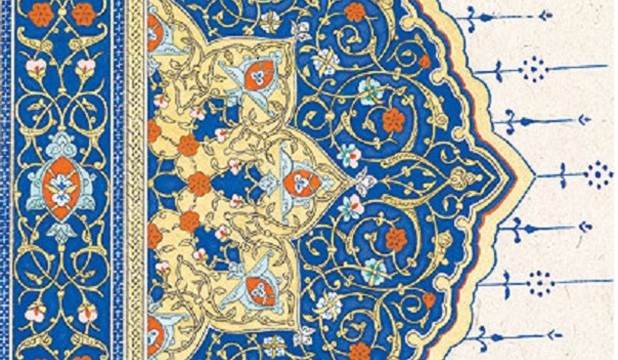
A section of a margin drawing from a copy of the Holy Qu’ran, painted recently in Kabul. (Museum of Islamic Art, Doha)
From March to July, Doha’s Museum of Islamic Art (MIA) is showcasing some of this rich history, together with contemporary work created by artisans in Afghanistan, in a major new exhibition entitled Ferozkoh: Tradition and Continuity in Afghan Art.
The exhibition is the product of a collaboration between the museum and the Turquoise Mountain Foundation, which supports traditional Afghan crafts and runs the Turquoise Mountain Institute for Afghan Arts and Architecture.
In 2012, Afghan students from the institute visited the MIA and were given special access to its collection of Afghan art and artifacts. They then returned to Kabul to begin work on their own pieces, inspired by the work they had seen in Doha.
Half of the objects are historical pieces from the MIA’s collection, the products of four great dynasties with connections to Afghanistan: the Ghaznavids, Timurids, Mughals and Safavids.
The second half presents works made especially for the exhibition by students of Turquoise Mountain, paired with the pieces that inspired them.
Dr. Leslee Michelsen, curator of the MIA and a specialist in the arts of Medieval Iran and Central Asia, says that Ferozkoh is at once a celebration of the richness of Afghan cultural heritage and a reminder that there is more to Afghanistan than the familiar narrative of conflict.
Dr. Michelsen said that the exhibition includes 39 pieces prepared especially for Ferozkoh and 40 from the existing collection of the MIA. She said: “This visit created a dialogue between past and present, old and new, the richness of tradition and the vibrancy of modern Afghanistan.”
“Our vision for the museum is one of a platform for positive community involvement with the cultural heritage of the past as well as the present,” Her Excellency Sheikha Al-Mayassa bint Hamad bin Khalifa Al-Thani, Chair of the Qatar Museums Authority, said.
Tommy Wade, director of the Turquoise Mountain Establishment, said: “Afghanistan has a richness of antiquities and fine art. The exhibition was one outcome of the seven years we spent setting up the establishment. Also, the exhibition helped Afghan students get out of Kabul to see Afghan heritage with the naked eye, to get a good idea of how the past mixed with the present.”
The institute and its specialized schools in the traditional industries of ceramics, woodwork and calligraphy, brings Afghan craft experts together with international advisers in an effort to maintain traditional skills, improve Afghan’s existing techniques and prepare new designs.
Students study five days per week and receive lessons in design, safety, materials, technical drawing, languages including Dari and English, information technology, and business management.
The institute is based in Kabul’s Murad Khane district, on the Kabul River, near the new city hotels and the old bird market. The area has been damaged by neglect, war and unscrupulous developers, but Murad Khane retains much of its original fabric, with a network of small streets connecting markets, religious structures, hotels and houses in a layout that represents the area’s unique ties to Islamic design and nearly four hundred years of Afghan history.
Its residents are a remarkable mixed ethnic and religious community, with Qizilbashis, Tajiks, Hazaras and Pashtuns living side by side despite the civil war.
Ferozkoh: Tradition and Continuity in Afghan Art runs at the Museum of Islamic Art in Doha, Qatar, until July 20, 2013. Further information on the exhibition can be found on the museum’s website.
